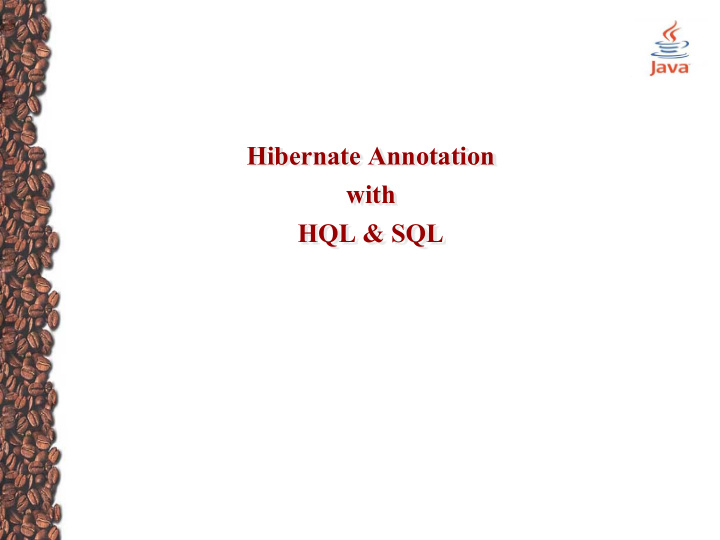



Hibernate Annotation with HQL & SQL
HQL HQL ย่อมาจาก Hibernate Query Language เป็นภาษาสอบถามเชิงวัตถุที่ใช้ สําหรับจัดการข้อมูลในฐานข้อมูลที่มีลักษณะคล้ายกับภาษา SQL ข้อแตกต่างระหว่าง SQL และ HQL ที่สําคัญ ๆ สามารถสรุปได้ดังต่อไปนี้ SQL มีพื้นฐานการทํางานมาจากระบบฐานข้อมูลเชิงสัมพันธ์ ในขณะที่ HQL เป็นการทํางานที่อาศัยหลักการเชิงวัตถุร่วมกับแนวคิดของ ฐานข้อมูลเชิงสัมพันธ์ SQL ใช้จัดการข้อมูลที่ถูกบันทึกลงในตารางและมีการแก้ไขผ่าน คอลัมน์และแถว ขณะที่ HQL เป็นการทํางานที่เกี่ยวข้องกับอ็อบเจกต์ และแอททริบิวต์ที่ถูกกําหนดไว้ SQL ใช้การทํางานจากความสัมพันธ์ที่เกิดขึ้นระหว่างตาราง ในขณะที่ HQL จะใช้การทํางานจากความสัมพันธ์ระหว่างอ็อบเจกต์
Hibernate query language : HQL HQL มีลักษณะเป็น case-insensitive ยกเว้นในกรณีที่มีการอ้างถึงชื่อคลาส และชื่อตัวแปรในจาวา From Clause: มีลักษณะเดียวกับ select clause ใน SQL Join Clause: HQL สนับสนุนการทํางานประเภท Join ได้แก่ inner join, left outer join, right outer join และ full join Aggregate ฟังก์ชั่น : count(*), count(distinct x), min(), max(), avg() และ sum() Expressions: HQL สนับสนุนนิพจน์ทางคณิตศาสตร์ (+, -, *, /) การ เปรียบเทียบ Binay (=, >=, <=, <>, !=, like) เปรียบเทียบลอจิก (and, or, not) HQL สนับสนุนคําสั่ง clauses ประเภท order by และ group by
Query interface เป็นอ็อบเจกต์ที่ถูกสร้างขึ้นจากการเรียกใช้เมธอด createQuery() จาก Session ประกอบไปด้วยเมธอดหลัก ๆ ดังนี้ public int executeUpdate() ใช้ประมวลผลคิวรี update หรือ delete public List list() คืนค่าผลลัพธ์จากตารางในรูปของ list public Query setFirstResult(int rowno) ระบุจํานวนแถวที่อ่านข้อมูล public Query setMaxResult(int rowno) ระบุจํานวนแถวข้อมูลที่ ต้องการอ่านจากตาราง public Query setParameter(int position, Object value) ใช้สําหรับ กําหนดค่าตําแหน่งพารามิเตอร์ตามรูปแบบการคิวรีข้อมูล public Query setParameter(String name, Object value) ใช้กําหนด ชื่อพารามิเตอร์ร่วมกับการคิวรีข้อมูล
Part of Student Class @Entity @Table (name="STUDENT") public class Student { @Id @GeneratedValue private int studentId; private String studentName; private String major; private double gpa ; public Student() {} public Student( String studentName, String major, double gpa) { this.studentName = studentName; this.major = major; this.gpa = gpa; } public String toString() { return " "+studentId+ " "+studentName + " "+major + " "+ gpa; } }
FROM Clause เป็นรูปแบบ HQL คิวรีที่ใช้โหลด Persistent อ็อบเจกต์เข้าสู่หน่วยความจํา โดยมีรูปแบบการใช้คําสั่งที่คล้ายกับภาษา SQL ดังนี้ HQL SQL FROM Student Select * from Student การใช้ HQL ต้องผ่าน Query อ็อบเจกต์ที่ประกอบไปด้วยเมธอดต่าง ๆ ที่ใช้ ในการควบคุมการประมวลผลคิวรีต่าง ๆ ดังตัวอย่างคําสั่งต่อไปนี้ String hql = "FROM Student"; Query query = session.createQuery(hql); List<Student> students = query.list();
list() : HQL ส่วนเมธอด list() ใช้สําหรับคืนค่าผลลัพธ์จากการคิวรีในรูปกลุ่มข้อมูลที่ถูก จัดเก็บภายใน List ดังตัวอย่างคําสั่งต่อไปนี้ String hql = "FROM Student"; Query query = session.createQuery(hql); List<Student> students = query.list(); System. out.println("Student Details: "); for(Student stu: students) { System. out.println(stu); } 1 Somchai Jaidee Information Technology 2.75 2 Somsri Jaipak Computer Science 3.1 3 Somrak Jaijing Information Technology 2.5 4 Somying Jaimon Computer Science 3.12
list() : SQL ส่วนเมธอด list() ของ SQL ใช้สําหรับคืนค่าผลลัพธ์จากการคิวรีในรูปกลุ่ม ข้อมูลภายใน Object[] ผู้ใช้ต้องแยกผลลัพธ์จากคําสั่งด้วยตัวเอง ดังตัวอย่าง คําสั่งต่อไปนี้ SQLQuery query = session.createSQLQuery("select * from Student"); List<Object[]> student = query.list(); ข้อมูล row ขึ้นอยู่กับลําดับของ System. out.println("Student Details: "); ข้อมูลภายในตารางฐานข้อมูล for(Object[] row : student){ System. out.print("Student ID: "+ row[0]); System. out.print(" Name: "+ row[1]); System. out.println(" Major: "+row[2]); System. out.println(" and GPA: "+row[3]); }
WHERE Clause ใช้ในกรณีที่ต้องการจํากัดผลลัพธ์ของการคิวรีให้แคบลงผู้ใช้สามารถใช้ WHERE clause เพื่อปรับแก้ผลลัพธ์ของอ็อบเจกต์ที่ต้องการคืนค่า โดยมี รูปแบบการใช้งานดังตัวอย่างคําสั่งต่อไปนี้ String hql = "FROM Student where studentId = 3"; Query query = session.createQuery(hql); List<Student> students = query.list(); System. out.println("Student Details: "); for(Student stu: students) { System. out.print(stu); } 3 Somrak Jaijing Information Technology 2.5
SELECT Clause คําสั่งนี้ช่วยให้การควบคุมผลลัพธ์จากการทํางานทําได้ดีกว่า from clause ในกรณีที่ต้องการอ่านค่า properties ของ objects ภายใน result ให้ใช้ select clause ตัวอย่างเช่น ในกรณีที่ต้องการอ่านค่าเฉพาะชื่อของ Student เท่านั้น ผู้ใช้ไม่ จําเป็นต้องอ่านค่าจากอ็อบเจกต์ทั้งหมด ดัง select clause ต่อไปนี้ String hql = "SELECT S.name FROM Student S"; Query query = session.createQuery(hql); List< String > names = query.list(); for(String stu: names) { System. out.println("Student name: "+ stu.toString()); }
Named Parameters Hibernate สนับสนุนการใช้ชื่อของพารามิเตอร์ในการคิวรีข้อมูล เพื่อเพิ่ม ความสะดวกในการเขียน HQL คิวรีรับข้อมูลอินพุตจากผู้ใช้ เช่นใ นกรณีที่ต้องการคิวรีข้อมูลเฉพาะ Student ที่มีค่า studentId เท่ากับ 1 สามารถใช้คําสั่ง setParameter() เพื่อกําหนดชื่อตัวแปร stu_id แทนได้ String hql = "FROM Student S WHERE S.studentId = :stu_id"; Query query = session.createQuery(hql); query. setParameter ("stu_id",( long)1); List <Student> results = query.list(); for(Student stu: results) { System. out.println(stu); }
Recommend
More recommend